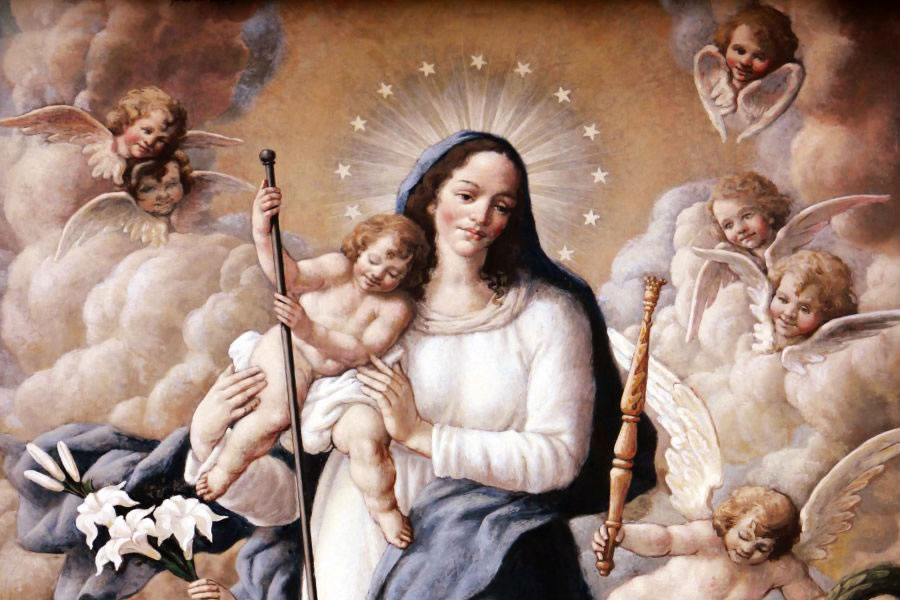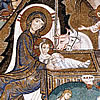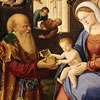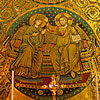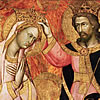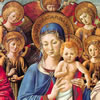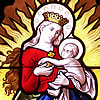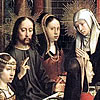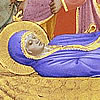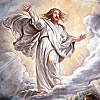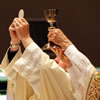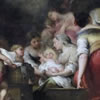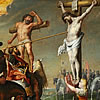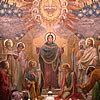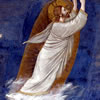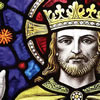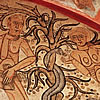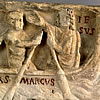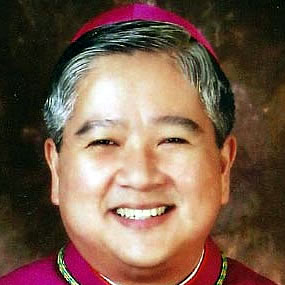The Most Holy Name of Mary
When Muslim Turks threatened to take the city of Vienna, it would have given them an entry point to the rest of Western Europe if they succeeded. To avert this threat, the Holy Roman Empire combined forces with the Hasburg Monarchy (of Vienna), and the Polish-Lithuanian Commonwealth. They were having difficulty at first, but when King John Sobieski of Poland entrusted himself to the Blessed Virgin Mary, the coalition started defeating the advancing menace. The victory dealt such a devastating blow to the Turks that it weakened them to the point of no longer becoming a threat to Christianity. It is this event that prompted Pope Innocent XI to commemorate the most holy name of Mary each September 12. But why not a memorial to Mary but to her name?
Names in the Bible are quite descriptive of the person to whom they belong. When God told Moses his “name” is YHWH (I am who am) he was describing his eternal nature. Abraham, for example, means “father of many,” for he was to be the patriarch of the Israelite nation. Simon was given the name “Peter,” which means rock for he was to be the cornerstone of the foundation the Church would be built on. Jesus means “YHWH saves” and describes that he is God who redeems humankind. So names mean a lot in Scripture.
The root of Mary can be traced to many ancient languages. In Hebrew, it means “bitter.” It reminds us of Naomi who, after losing her husband and two sons, cried out, “don’t call me Naomi (which means sweet). Call me Mara (which means bitter.)” (Ruth 1:20) In that time and culture, since widows have no husbands to work, they were sure to face financial ruin and starvation. But as we read on, Boaz marries Naomi in what is called a “redeemer-relative.”
It is a foreshadowing of Mary who is a personification of “daughter Israel” who is bitter because her children have been exiled, and whose land has been oppressed by one aggressor or another. But Jesus comes as the bridegroom who would redeem his Church by making her his bride. Since the Church is the larger “expression” of Israel, we can see why we call the Church the Bride of Christ. So when we mention Mary’s name, we are meant to remember Christ our Redeemer.
In the book Jesus of Nazareth: The Infancy Narratives by Benedict XVI, he comments that the syntax of Gabriel’s greeting to Mary helps us understand God’s name for Mary. The angel’s greeting is, “Hail, Full of Grace,” and the words that come after “Hail” are usually a name or title, for example, “Hail, Caesar,” or in darker years much later, “Heil, Hitler.” So, if we were to follow the syntax, it would indicate that “Full of Grace” is God’s name for Mary. This isn’t a new insight because Benedict XVI only echoes what the Church Fathers have discussed early in the Church’s history. Early scholars suggest that God sees Mary as “Full of Grace” for she was filled with grace from the moment of her conception – basically, the dogma of her Immaculate Conception.
In connection with this, philological studies also suggest that Mary, in Ancient Egyptian, means “beautiful one, or well-beloved.” Spiritual beauty is so loveable to God’s eyes. The spiritual perfection of Mary was so attractive to God that she became the object of the Blessed Trinity’s most tender love that hasn’t been expressed to any other creature. The Father loved Mary so much that he allowed her to be the Mother of his only Son. In this way, he closely united her with his saving plan for humankind.
The Son showed his love to Mary by being subjected to her for thirty years. (Luke 2:51) When it was time for him to step out of his “hidden life,” it was through a spectacular miracle of turning water into wine in Cana at her suggestion. One of the last acts of the Son was to show love to Mary when he provided for her by giving her to the care of St. John.
The idea of Mary, in God’s mind, must have been so loveable that the Holy Spirit foretold of her coming by enlightening the prophets generations before she was conceived. She is like a song in God’s mind whose chorus repeats time and time again on the lips of his spokespersons, the prophets.
While we enjoy the indwelling of the Holy Spirit only from the moment of our baptism, the Holy Spirit showed how much he loved Mary by dwelling in her from the moment of her conception. He could not allow the devil to have dominion over her so he protected her from sin throughout her whole life.
The Father loves the Son because the Son is the perfect expression of the Father. Mary, on the other hand, is the perfect reflection of God’s beauty. From all eternity God saw this, so we can understand why he loves her so much. In the Song of Song, the bridegroom echoes God’s love for his bride as he tells her, “How beautiful is your love, my sister, my bride… You have ravished my heart with one glance of your eyes.” (Song of Songs 4:9-10)
Mary’s name then should evoke two things in us: God’s love for her and God’s love for all mankind proven by the Passion he suffered for our redemption. Let us speak her name in thanksgiving and praise to God.

A Sky Full of Stars
Know Our Lady through her Titles in the Litany
The Church helps us understand who Mary is by honoring her with different titles in the Litany of the Blessed Virgin Mary. Unfortunately, over time and difference of culture, we might not grasp what it is the Church is ascribing to her and lose that opportinity to get to know her.
In A Sky Full of Stars, each title of the Litany is explained so we get know Mary more and fall in love with her all over again.
Get your copy now either in Hardbound, Paperback, or Kindle
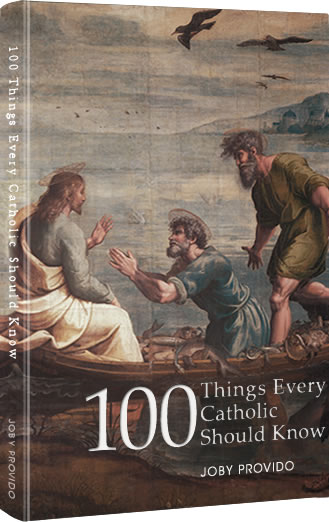
100 Things Every Catholic Should Know
Whether or not you are new to the Catholic Church, or struggling, or lapsed, or dynamically involved, this book will enlighten you with the essentials of the Faith that have been handed down to us by the apostles.
Each of the 100 topics is easy to read and distilled into bite-sized portions. Through cross-referencing, the book also shows how the topics are interrelated. Those who are new to the Faith will find this book an edifying handy reference, and those who have simply forgotten will find it a great review material that might spark a new love for God and religion.
Get your copy now either in Hardbound, Paperback, or Kindle
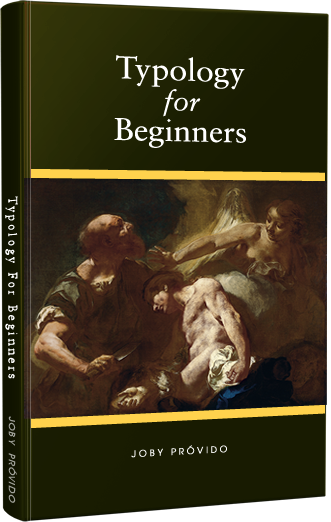
Typology for Beginners
A Catholic Perspective on understanding the New Testament through the Old Testament
First-century Jews converted to Christianity in droves because of the way the New Testament was written to show Jesus was the Messiah promised by the Old Testament. We also learn about how Mary is the New Eve and the Ark of the Covenant in the way the writers portray her.
Through typology, the patterns that connect the Old and New Testaments make the Bible stories more accessible so that one becomes excited to read Sacred Scripture again.
Get your copy now either in Hardbound, Paperback, or Kindle
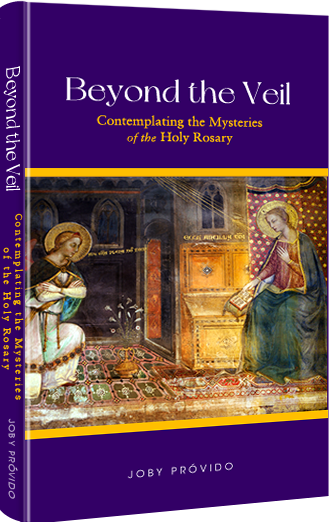
Beyond the Veil
Contemplating the Mysteries of the Holy Rosary
Prayer giants like Pope St. John Paul II, Pope Paul VI, Bl. Archbishop Fulton Sheen, and Bishop Robert Baron advocate that we contemplate on the mysteries of the rosary while we say the vocal prayers. Unfortunately, there are not many books that teach us how to do this. Beyond the Veil comes to the rescue by suggesting seven ways we can pray the rosary the way it was intended.
The larger part of the book offers mental images for each of the mysteries we can use in our contemplation, for how can we imagine the scenes in the rosary if we don't know about them?
Get your copy now either in Hardbound, Paperback, or Kindle


